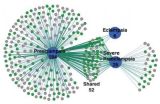(Press-News.org) A Virginia Tech team of researchers has proven that homemade, inexpensive stink bug traps crafted from simple household items outshine pricier models designed to kill the invasive, annoying bugs.
This discovery comes just as warm weather is coaxing the critters out of crevices of homes they were hiding in during the cold winter and homeowners will be looking for a way to get rid of the pest.
Researchers in the College of Agriculture and Life Sciences found that the best way to get rid of the little buggers is to fill a foil roasting pan with water and dish soap and put a light over the pan to attract the bugs in a dark room. The trap eliminated 14 times more stink bugs than store-bought traps that cost up to $50, the study found. The only price of the homemade model is the cost of a roasting pan, dish soap, and a light, all which homeowners may already own.
Though the solution is not new and has been promoted on Youtube and other websites, this is the first time it was actually tested in a scientific experiment.
The findings of the study can be found in a soon to be published issue of the Journal of Extension.
Virginia Tech created a video showing how to build a trap.
"We knew that insects are generally attracted to light, so we were able to exploit that with these traps," said John Aigner, a doctoral student in the Department of Entomology.
To conduct the study, Aigner and Tom Kuhar, an entomology professor and Virginia Cooperative Extension specialist, enlisted the help of citizen scientists — homeowners who were annoyed by the infestation of stink bugs in their houses — to evaluate different types of traps for ridding homes of bugs. The study was conducted in 16 houses over two years.
"Currently there are no in-home insecticides labeled for use against brown marmorated stink bugs, so that presented us with a challenge," Aigner said.
The homemade trap is not only inexpensive, it is also pesticide-free.
Unfortunately, the traps are only practical in homes. Farmers in the mid-Atlantic region have faced millions of dollars in damage to their crops since the brown marmorated stink bug invaded the mid-Atlantic region in the late 2000s. The bug is now found in 41 states. Still, the solution could give some reprieve to homeowners who find thousands of these cilantro-smelling bugs in their homes.
"The real devastation comes in the form of damage to farmers," said Kuhar. "Stink bugs feed as nymphs and adults on the fruit and pods of plants, which maximizes their chances to render a crop unmarketable. These bugs have been documented to feed on many of our important agricultural crops including apples, peaches, grapes, soybean, peppers, tomatoes, corn and cotton."
Treatment of the insects in crops is costly because the insecticides required to control it are broad spectrum toxicants that are highly disruptive to integrated pest management programs.
"The few native natural enemies they have can easily be killed with the same insecticide used to target the stink bugs themselves," he said.
INFORMATION: END
Homemade stink bug traps squash store-bought models, Virginia Tech researchers find
Traps are inexpensive, effective, and pesticide-free
2014-05-08
ELSE PRESS RELEASES FROM THIS DATE:
Athletes' fear of failure likely to lead to 'choke,' study shows
2014-05-08
A new study by sports scientists at Coventry University and Staffordshire University shows that anxiety about a competitive situation makes even the most physically active of us more likely to slip-up.
The research, which is set to be presented at the British Psychological Society's flagship annual conference this week, tested the anticipation and coordination abilities of 18 active and healthy young adults during two sets of identical physical tests – one ostensibly a practice, the other a competition.
In the 'competitive' trials, researchers found that the participants' ...
Musical training increases blood flow in the brain
2014-05-08
Research by the University of Liverpool has found that brief musical training can increase the blood flow in the left hemisphere of our brain. This suggests that the areas responsible for music and language share common brain pathways.
Researchers from the University's Institute of Psychology, Health and Society carried out two separate studies which looked at brain activity patterns in musicians and non-musicians.
The first study looking for patterns of brain activity of 14 musicians and 9 non-musicians whilst they participated in music and word generation tasks. The ...
The Lancet: Antipsychotic medication associated with reduced rate of violent crime
2014-05-08
People who use antipsychotic medication (such as clozapine or risperidone) to treat psychiatric illness are nearly half as likely to commit a violent crime compared to when they are not using such medication, according to new results published in The Lancet. The use of mood stabilising drugs (such as lithium or carbamazepine) is also associated with a reduced rate of violent crime, although the reduction is less pronounced, and only in patients with bipolar disorder.
Antipsychotic and mood stabilising medication are used to treat a variety of disorders, but are most commonly ...
Study suggests improved survivorship in the aftermath of the medieval Black Death
2014-05-08
Human mortality and survival may have improved in the generations following the Black Death, according to results published May 7, 2014, in the open access journal PLOS ONE by Sharon DeWitte from University of South Carolina.
As one of the most devastating epidemics in human history, the medieval Black Death (c. 1347-1351) killed tens of millions of Europeans. Previous studies have shown that the disease targeted elderly adults and sick or stressed people; however, not much is known about any substantial changes in the population, like overall health and mortality, before ...
Scientists focus on role of ventilation in preventing tuberculosis transmission
2014-05-08
Scientists studying the role of room ventilation in tuberculosis transmission found that students in Cape Town, South Africa, spend almost 60 percent of their day in poorly ventilated rooms, at risk of transmission, according to results published May 7, 2014, in the open access journal PLOS ONE by Eugene Richardson from Stanford University School of Medicine and colleagues. The researchers propose an increase in low-cost, WHO-compliant natural ventilation to facilitate healthy indoor environments and reduce risks.
Despite biomedical improvements to treat tuberculosis ...
A new tool to measure the speed of aging
2014-05-08
A physical test for measuring age shows wide differences between the rates of aging among different population groups, according to new research by demographers at the International Institute for Applied Systems Analysis.
A strong handshake can say a lot about a person—it can indicate power, confidence, health, or aggression. Now scientists say that the strength of a person's grasp may also be one of the most useful ways to measure people's true age.
In a new study published today in the journal PLOS ONE, IIASA researchers Serguei Scherbov and Warren Sanderson (also at ...
UH Rainbow study finds rising incidence of acute pancreatitis in hospitalized children
2014-05-08
The largest investigation to date has found a significant increase in the number of acute pancreatitis (AP) cases in hospitalized children in the United States.
The new study, in the "PLOS ONE" journal found a 51 percent increase in the primary diagnosis of AP from 2000 to 2009. The number increased from 6,350 in 2000 to 9,561 in 2009.
The study looked at hospitalization records of patients 20 years old and younger using a federal children's inpatient database. From 2000 to 2009, they identified 55,012 cases of AP in hospitalized children ages 1 – 20.
According ...
Study finds genetic patterns in preeclampsia
2014-05-08
PROVIDENCE, R.I. [Brown University] — Different manifestations of preeclampsia, such as early vs. late timing or typical vs. high severity, appear to have distinct genetic underpinnings, suggesting that they may need to be studied and treated differently. That and several other insights are described in a newly published comprehensive review of genetic studies of the condition, which produces life-threatening complications such as high-blood pressure in as many as 8 percent of pregnancies in the United States.
"There are probably very different phenotypes of preeclampsia ...
Experts say 'insourcing' innovation may be the best approach to transforming health care
2014-05-08
Philadelphia - A group of health care and policy experts from the Perelman School of Medicine at the University of Pennsylvania is urging health care institutions to look more to their own in-house personnel, including physicians and nurses, as a source of new ideas for improving how care is delivered. The practice – referred to as insourcing – relies on an organization's existing staff to drive needed transformations. The team also suggests a four-stage design process which, when adopted internally, may help organizations implement more efficient health care delivery solutions. ...
New order of marine creatures discovered among sea anemones
2014-05-08
A deep-water creature once thought to be one of the world's largest sea anemones, with tentacles reaching more than 6.5 feet long, actually belongs to a new order of animals. The finding is part of a new DNA-based study led by the American Museum of Natural History that presents the first tree of life for sea anemones, a group that includes more than 1,200 species. The report, which is published today in the journal PLOS ONE, reshapes scientists' understanding of the relationships among these poorly understood animals.
"The discovery of this new order of Cnidaria—a phylum ...
LAST 30 PRESS RELEASES:
iPS cells from dish to freezer and back
Deep neural networks enable accurate pricing of American options under stochastic volatility
Collective risk resonance in Chinese stock sectors uncovered through higher-order network analysis
Does CPU impact systemic risk contributions of Chinese sectors? Evidence from mixed frequency methods with asymmetric tail long memory
General intelligence framework to predict virus adaptation based on a genome language model
Antibiotic resistance is ancient, ecological, and deeply connected to human activity, new review shows
Vapes, pouches, heated tobacco, shisha, cigarettes: nicotine in all forms is toxic to the heart and blood vessels
From powder to planet: University of Modena engineers forge a low-carbon future for advanced metal manufacturing
Super strain-resistant superconductors
Pre-school health programme does not improve children’s diet or physical activity, prompting call for policy changes, study finds
Autumn clock change linked to reduction in certain health conditions
AI images of doctors can exaggerate and reinforce existing stereotypes
Where medicine meets melody – how lullabies help babies and parents in intensive care
We may never be able to tell if AI becomes conscious, argues philosopher
AI video translation shows promise but humans still hold the edge
Deep ocean earthquakes drive Southern Ocean’s massive phytoplankton blooms, study finds
Without campus leftovers to pick through, the beaks of this bird changed shape during the pandemic
High-dose antibiotic does not reduce mortality in tuberculous meningitis
How many insects fly in the sky above the USA?
Could cheese protect your brain health?
Who faces more difficulty recovering from stroke?
Colliding galaxies create the brightest, fastest growing black holes at their center
New BrainHealth research reveals tradeoffs on sleep with cannabis use for chronic pain
Aging-US now on ResearchGate, enhancing visibility for authors and readers
'Molecular glue' stabilizes protein that inhibits development of non-small cell lung cancer
Mount Sinai Health System is recognized in 2025 Chime Digital Health Most Wired survey
From prey to predator: How carnivores spread beneficial fungi
Menopause symptoms may be frequent and have negative effects, according to female endurance athletes
US Congressmembers’ responses on X to mass shooting events differ along party lines
KAIST-UEL team develops “origami” airless wheel to explore lunar caves
[Press-News.org] Homemade stink bug traps squash store-bought models, Virginia Tech researchers findTraps are inexpensive, effective, and pesticide-free




